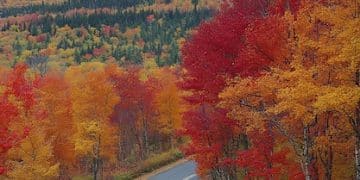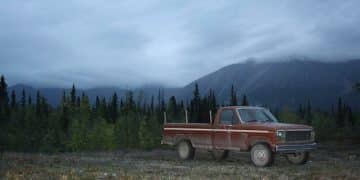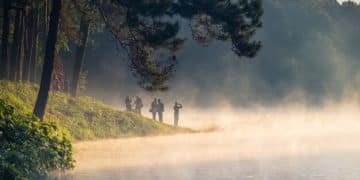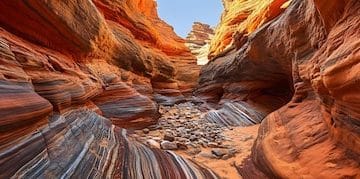Canoeing & Kayaking USA 2025: Top Waterway Adventures
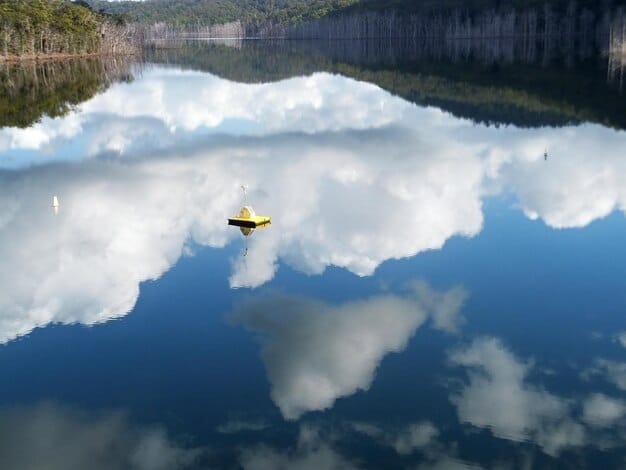
Canoeing and kayaking adventures in the USA offer diverse experiences, from tranquil lakes to challenging rapids. This guide highlights top waterways and essential tips for planning your 2025 paddling trips.
Embark on unforgettable canoeing and kayaking adventures: a 2025 guide to paddling America’s waterways with this comprehensive guide. Discover stunning destinations and essential tips for your next water journey.
Planning Your Canoeing or Kayaking Trip in 2025
Planning a canoeing or kayaking trip involves several key considerations. From choosing the right location to ensuring you have the necessary gear and skills, careful preparation is essential for a safe and enjoyable experience. Let’s look at the integral factors.
Choosing the Right Location
The location you choose will significantly impact your experience. Consider factors like the type of water (lake, river, or ocean), the difficulty level, and the scenery.
Essential Gear and Equipment
Having the right gear is critical. This includes your canoe or kayak, paddle, personal flotation device (PFD), and appropriate clothing. Additional items like a dry bag, first-aid kit, and navigation tools can also be beneficial.
- Ensure your PFD fits properly.
- Use a waterproof bag to protect electronics and valuables.
- Carry a whistle for emergencies.

Proper planning ensures a smooth and memorable canoeing or kayaking adventure, setting the stage for exploration and enjoyment on America’s waterways. Consider these factors to make informed decisions and ensure a safe and enjoyable trip.
Top Canoeing and Kayaking Destinations in the USA
The United States boasts a wealth of incredible canoeing and kayaking destinations. From serene lakes to thrilling rivers, there’s something for every skill level. Let’s explore some top locations for your next adventure.
Boundary Waters Canoe Area Wilderness, Minnesota
Known for its pristine lakes and dense forests, the Boundary Waters offers a true wilderness experience. This area is ideal for multi-day canoe trips with portages connecting various lakes and rivers.
The Colorado River, Arizona and Utah
Paddling along the Colorado River offers breathtaking views of the Southwest’s dramatic landscapes. Sections like the stretch near Moab, Utah, are popular for kayaking and rafting adventures.
- Obtain necessary permits for the Boundary Waters.
- Check river conditions and water levels on the Colorado River.
- Be aware of wildlife in both areas.
These destinations provide unforgettable paddling experiences, showcasing the natural beauty of the United States. Consider these top spots when planning your canoeing or kayaking adventure to ensure a memorable trip.
Preparing for Different Water Conditions
Different water conditions require different skills and preparations. Understanding how to handle various scenarios is crucial for staying safe and having a positive experience. Let’s look at adapting to different water types.
Lakes and Calm Waters
Paddling on lakes and calm waters is generally easier, but it’s still important to be aware of weather conditions. Wind can quickly create choppy waters, making paddling more challenging.
Rivers and Rapids
Rivers offer a more dynamic experience, with currents and rapids to navigate. Know your abilities and choose rivers that match your skill level. Always scout rapids before attempting to paddle through them.
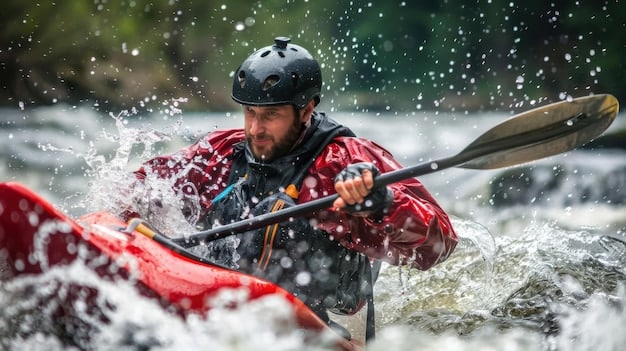
Being prepared for different water conditions ensures a safe and enjoyable canoeing or kayaking trip. By understanding the challenges and adapting your skills, you can confidently navigate various waterways.
Essential Safety Tips for Paddling
Safety should always be a top priority when canoeing or kayaking. Following essential safety tips can minimize risks and ensure a safe and enjoyable experience. Let’s focus on some crucial safety guidelines.
Wear a Personal Flotation Device (PFD)
Always wear a properly fitted PFD. It’s the most important piece of safety equipment and can save your life in an emergency.
Check Weather Conditions
Before heading out, check the weather forecast. Avoid paddling in adverse conditions such as thunderstorms, high winds, or fog.
- Carry a signaling device like a whistle.
- Inform someone of your planned route and expected return time.
- Know how to self-rescue or assist others in case of a capsize.
Following these essential safety tips can greatly reduce the risks associated with canoeing and kayaking, ensuring a safer and more enjoyable experience on the water.
Canoeing and Kayaking Gear: What You Need
Having the right gear can make a significant difference in your comfort and performance on the water. From the basic essentials to specialized equipment, here’s a guide to what you need.
Basic Gear Essentials
The basic gear includes your canoe or kayak, a paddle, and a PFD. These are essential for any paddling trip, providing buoyancy, propulsion, and safety.
Clothing and Accessories
Wear appropriate clothing for the weather conditions. Layering is key, as it allows you to adjust to changing temperatures. Accessories like hats, sunglasses, and sunscreen are also important.
- Consider investing in a quality paddle for improved performance.
- Use a spray skirt in kayaks to keep water out of the cockpit.
- Bring a repair kit for minor equipment issues.
Equipping yourself with the right gear ensures you’re prepared for various conditions, enhancing both your safety and enjoyment on the water. Investing in quality gear can improve your overall paddling experience.
Staying Safe with Wildlife Encounters
When paddling in natural areas, you may encounter wildlife. Knowing how to react in these situations is essential for both your safety and the well-being of the animals. Let’s explore guidelines for wildlife encounters.
Understanding Local Wildlife
Learn about the types of wildlife you may encounter in your chosen area. This knowledge will help you anticipate potential interactions and understand appropriate responses.
Keeping a Safe Distance
Maintain a safe distance from wildlife. Never approach or attempt to feed animals, as this can alter their behavior and create dangerous situations.
- Store food properly to avoid attracting animals to your campsite or paddling area.
- Make noise to alert animals to your presence, reducing the chance of startling them.
- Carry bear spray in areas where bears are common.
Being aware and respectful of wildlife ensures a harmonious experience in nature, protecting both yourself and the animals. Understanding how to react responsibly can prevent negative encounters.
| Key Point | Brief Description |
|---|---|
| 📍 Top Destinations | Explore Boundary Waters, Colorado River for stunning views. |
| 🛶 Essential Gear | Kayak/canoe, paddle, PFD, waterproof bag. |
| safety First | Always wear a PFD, check weather conditions, and inform someone of your plans. |
| 🐻 Wildlife Awareness | Keep a safe distance and avoid feeding animals. |
Frequently Asked Questions
▼
The best time for kayaking depends on the location and weather. Generally, late spring and early fall offer pleasant temperatures and fewer crowds. Summer can be ideal, but be prepared for heat and potential thunderstorms.
▼
Essential safety items include a properly fitted personal flotation device (PFD), a whistle or signaling device, a first-aid kit, and a waterproof bag for valuables. It’s also wise to carry a map and compass.
▼
Consider the type of water you’ll be paddling in, your skill level, and the number of people you’ll be carrying. Kayaks are often preferred for speed and maneuverability, while canoes offer more space and stability.
▼
Wear moisture-wicking clothing and dress in layers to adjust to changing temperatures. A hat, sunglasses, and sunscreen are also crucial. In cooler weather, consider wearing a wetsuit or drysuit for added warmth.
▼
Maintain a safe distance from wildlife and avoid feeding animals. Store food properly to prevent attracting unwanted attention. Make noise to alert animals to your presence and carry bear spray in bear country.
Conclusion
Exploring America’s waterways through canoeing and kayaking offers unparalleled adventures and breathtaking views. By following this 2025 guide, you can ensure a safe, enjoyable, and memorable paddling experience, discovering the beauty and tranquility of nature.
